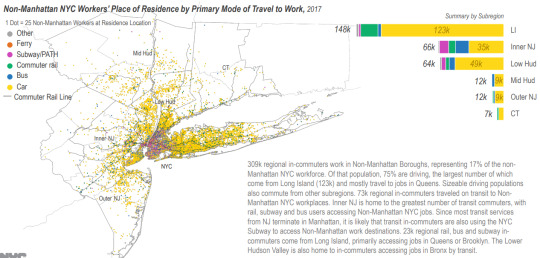#statistical maps
Text
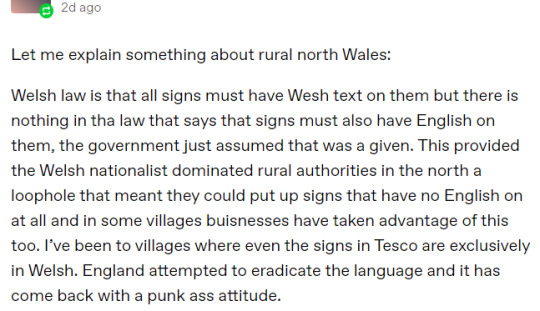
Bad Takes in the Welsh tag vol. II- this reblog on a post about the number of Welsh speakers. (I have cropped out the username of OP and as ever, I only focus on the sentiment, not the person. If you know OP's url kindly do not send them anon hate etc.).
So I saw this take a few days ago in a reblog on a post in the Welsh tag and wanted to address this sentiment as well, since it does the opposite of that other bad take that I saw and made a post about the other day. To be clear, I don't disagree entirely with OP, but there's an element of wishful thinking that I sometimes see when it comes to Welsh / other minoritised languages which can end up doing more harm than good.
This screenshot was also discussed in the LGBTQIA+ Welsh Discord I run and the broad consensus from those of us in there who live in Wales is that OP is painting a very inaccurate picture of the status of Welsh, particularly of Welsh in North Wales. It is frustrating when you have people who value Welsh, but don't value Welsh enough to bother with accuracy in their promotion of the language. This post is intended as a gentle reminder that we can fight for the Welsh language without misrepresenting the situation on the ground so to speak.
The post itself has a 'fuck yeah, Welsh!' attitude which I personally love. But sadly this particular post is riddled with misinformation. First of all, we have "Welsh law is that all signs must have We[l]sh text on them but there is nothing in the law that says signs must also have English on them". Now the wording is kinda vague here- but I'm going out on a limb and saying that the OP is likely referencing The Welsh Language Standards Guidelines (which have been updated several times over the years). The guidance has a number of Standards relating to signs in the Welsh language, such as Standard 32, Standards 47-52, Standard 66 and Standards 111-113. The section of Interpreting the Standards also contains relevant text, such as in Part 3- Interpreting the Standards article 15:

Plain text: "For the purposes of the standards a requirement to publish, provide or display any written material in Welsh does not mean that material should be published, provided or, displayed in Welsh only, nor does it mean that the material should be produced in Welsh first (unless that is specifically stated in the standard)"
Of the Standards listed above, Standards 47-52 are specifically designated as Standards relating to signs and notices displayed or published by a body. Which state things like "... if the same text is displayed in Welsh and in English, you must not treat the Welsh language text less favourably than the English language text" - Standard 47 and "You must ensure that the Welsh language text on signs and notices is accurate in terms of meaning and expression" - Standard 49.
Anyway, back to the point. OP is incorrect in stating that there is a loophole by which the Welsh Law forgot to specify that the signs had to have English as well as Welsh and that public bodies can get away with monolingual Welsh signs. This just isn't true. Important to note is that the law is intended for public bodies- so big companies, road signage makers etc. This guidance isn't for random farms in North Wales which have signs that say "wyau <-" pointing up the lane with no English translation.
Now, the next sentence is a little loaded, well-meant, but a little loaded nonetheless. "The Welsh nationalist dominated rural authorities in the North"- it's loadedness comes down to its vagueness I think. While it isn't wrong per se that Welsh Nationalist parties like Plaid Cymru do well in the North West, it is a little skewed to ascribe Welsh speaking status to whichever party is doing the best in a given area. It isn't that clear cut, unfortunately. To get into this issue, we have to talk maps.
So those Welsh speaker maps that have nice gradients and have the West of Wales coloured in dark, gradually getting lighter as you move East? Unfortunately, these maps can be very misleading (especially if, like in the map OP was commenting on, the source of the data was left off). But the long and short of it is- these maps tend to imply that Welsh is exclusively spoken in the NW and that everywhere East of Bangor has had it. But the data presentation is very flawed, since it tends to erase Welsh language gains in places like Cardiff, Swansea and Monmouthshire.
You've all seen maps like this right? NW in the darkest colours and SE in the lightest?
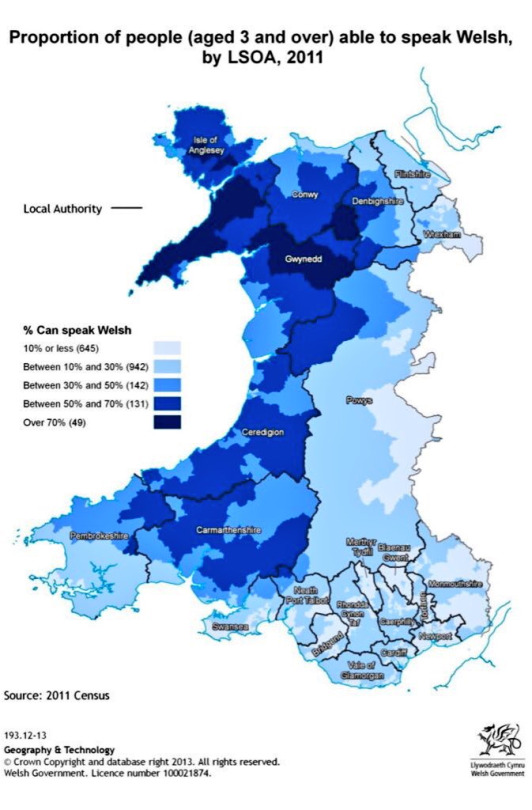
Unfortunately when it comes to these kinds of maps, they can be very misleading from a language revitalisation point of view.
Here's some maps I actually studied at undergrad for this purpose

On the face of it, your eyes zip up to Gwynedd and Môn on the first map and then over to the second and- 'oh no!' you might say, there's been a -2.1 to -4.0 percent decline in Welsh speakers in those areas. And of course, this is something that language revitalisation wants to address. But look at the first map again. Look at, Monmouthshire, Caerphilly, Cardiff and Swansea. Then look at the second map.
Welsh speaking is actually being increased in these areas, between 2001 to 2011.
The misleading nature of a language map like this one is not its borders, its colour or key, but its omission of the sociopolitcal forces at play in language revitalisation. Large population centres like Cardiff, Caerphilly, Newport and Swansea are actively gaining more Welsh speakers. While Gwynedd and Môn are losing some. But Welsh speaking (despite a few wobbles) is on the increase. So where did those Welsh speakers from the North go?
South.
It isn't a hard-and-fast rule, but many rural Welsh speakers (especially those who live in areas with high amounts of holiday homes which drive up rent/cost of staying in villages in North Wales) actually end up moving to more urban areas in the South, meaning that some of the decline of Welsh speaking in North Wales is down to Welsh speakers just, moving to a different part of Wales- which in turn makes those areas see an increase in Welsh being spoken.
Of course, we actually have to address the cause of the exodus of Welsh speakers from rural areas holiday homes raising house prices making them unaffordable for locals and drives them away but the way that our data is represented is not as dire as it looks. Still not great, mind, but not apocalyptic either.
Then there's the other inaccuracies in this post. Small businesses like farm shops, high street businesses and houses can have Welsh-only signage because they are not local authorities and much of the guidance indirectly referenced by OP mostly only applies to local authorities. This is how you have farm shops advertising produce in Welsh only, or shop names in Welsh (such as Siop y Pethe and Broc-Môr in Aberystwyth) or the name of the house my flat is in. Businesses have different regulations for signage inside the shop in different situations. But the guidance indirectly referred to by OP in the screenshot mostly applies to road signage.
Big name brands such as Tesco are definitely not going to have monolingual Welsh stores and it is disinformation to suggest that they do- especially not when they've made gaffes such as "sboncen" to mean squash (the drink). "Sboncen" means squash (the sport), while they should have put "sgwash", meaning the drink.

Or my favourite instance of these "arwyddion gwael", in which instead of offering a free ATM service, this ATM on the Tesco Express in Aberystwyth offered "codiad am ddim" (free erections):

So I dread to think what a fully monolingual poorly translated Welsh Tesco would look like.
I don't disagree with OP on the final part, that we should celebrate Welsh's "punk ass attitude" in surviving despite attempts to eradicate it from existence. But spreading false information is definitely not the way we should be doing that.
Instead, we can celebrate things like the National Eisteddfod coming to places like Wrecsam in 2025, which aren't typically selected due to there being fewer speakers. But what bringing the National Eisteddfod to areas with low-speakers does is reestablish that yes, actually, Welsh deserves to be spoken all over Wales, not just in Y Fro Gymraeg (Welsh concept equivalent of the Gaeltacht in Ireland). It's an active, real reclamation of areas previously lost for Welsh and revitalising them by bringing the language back with the biggest Welsh language event anywhere.
218 notes
·
View notes
Text
Újtumblitérképek
Közkívánatra (egy ember írta hogy érdekli), itten van pár újtumblitérkép!
Kezdjük a COVID generációval, azaz a 2020 januártól napjainkig:
A ranglistát továbbra is pajjor-kazi vezeti, a blogok 14.34%-val
Utána jön haztartasi-keksz és orulunkvincent, 10.66%-al
Harmadik: kozimacanto - tryagain 2.41%
Negyedik: szupertibi - tobbpenztazembereknek 2.39%
Ötödik: sztupy - willcodehtmlforfood 2.35%
Hatodik: ko1azer0 - tallianmiklos 2.16%
Hetedik e52711 - trilliannnn, 1.67%
Nyolcadik helyre még felfért kinlodok - naposmedve, 1.55%
(algebraicvarietyshow-vampirpillango pont lecsúszott az 1%-os bejutási küszöbről 0.97%-al)
Ha csak az elmúlt két évet nézzük akkor a helyzet:
pajjorimre lecserélte válogatáskazit habkeinb0ck-ra, a blogok 26.57%-át lefedve ezzel
haztartasi-keksz - orulunkvincent 11.87%
otthonzulles - tenykozleseim 5.25%
b-eton-loofie - rpszt 1.66%
szupertibi - tobbpenztazembereknek, 1.52%
A többiek jóval az 1%-os bejutási küszöb alatt
És ha kizárólag csak a tavalyi év érdekel:
Első helyről lecsúszott pajjorimre, helyét haztartasi-keksz - orulunkvincent vette át a blogok 25.67%-val
Második az otthonzulles - tenykozleseim 16.15%-al (pajjor is ide tagozódott be)
Harmadik sztupy - willcodehtmlforfood 5.70%-al
Negyedik szupertibi - tobbpenztazembereknek 3.17%-al
Ötödik habkeinb0ck - triceramopsz, a blogok 2.64%-al
Hatodik hulla - millenovecentoottanta, 1.18%
Hetedik helyre még felfért kamublogok - ko1azer0, 1.06%-al
127 notes
·
View notes
Video
Police Violence
https://mappingpoliceviolence.org/
280 notes
·
View notes
Note
Have u seen the survey about "the most culturally chauvinistic Europeans"? I think you're gonna get a good laugh out of it
I laughed but it was a sad laughter. I had seen this map before but I have thoughts about it, in fact more for the other countries than Greece, and I will grasp this opportunity to discuss it here.

Okay lol I do not doubt at all that Greece is the most CULTURALLY (discreet emphasis) chauvinistic country. But I would like to discuss the data a little.
Although I would expect Greece to be at the top, I am a little surprised by the exact percentage. There are so many Greeks who are leftist, liberal, progressive and citizens of the world. This means that a large percentage of them also agreed that their culture is superior?! Or maybe the sample was not very diverse?
I did think the west would have lower percentages for reasons I will mention in a minute but I simply do not believe the percentages would be that low. No offense to anybody but neither Italy’s nor France’s percentage seems remotely realistic to me. I don’t know much about Spain’s case but I find this strange as well. Honestly no offense, a person from the 89% country is telling you that, you couldn’t get worse than this 😅 But some general attitudes I have observed, also from the center and the north, don’t make these look totally accurate unless I have stumbled onto all the weirdos.
I think a real factor that is ultimately not taken into consideration here is that it has been WAY more integrated in the western nations’ mentality to believe that appearing culturally chauvinistic is NOT OKAY. The very low percentages of France and Spain kinda scream ex colonialist guilt as well. This mindset has not spread nearly as much in the east. Because of less progressiveness but also because of less guilt, Eastern Europeans are way more brutally honest and less apologetic about how they feel regarding their cultures. Greeks also have all the cradle of western civilisation jazz following them, although they’re essentially easterners, which skyrockets their unapologetic stance.
In short, while I think the results have a lot of truth, I believe the gaps between east and west are not very sincere as western people are taught to believe it is not at all okay to express “too much” respect for their own culture but sometimes their acts show it more. At least enough to not be that low. They would still be lower anyway though, no objection to that.
And as a last note; you just know that a lot of the Greeks are just parroting things and have no clue about Greek culture apart from white statues, souvlaki and Syrtaki TM
21 notes
·
View notes
Text
Had a bizarre experience this week, where I thought “where are my keys?” And then I immediately pictured the last place where I had placed my keys, and then, when I went to that place, lo and behold, my keys were there.
#cyborg lifeblogging#this ever happened to anyone before ?#or is this what it’s like for most people?#cuz for me it’s usually more like. a heat map of locations where it is statistically likely for my keys to be
14 notes
·
View notes
Text
Listen Awakenings map design is not good. But I would call it incredibly MEMORABLE because everytime I think about the evils walls of Severa's paralogue. Or the Mila Tree (rot) or the cliffside map with Ricken. Or the Volcano. Or the boats. Or the Walhart hall. Or the Walhart castle assault. Or the-
My blood pressure rises okay. Awakening is in my brain forever
#fire emblem#'your average Awakening map has little terrain' statistical error. Mila's georg. which has NO TERRAIN-
3 notes
·
View notes
Text
A choropleth map (from Greek χῶρος (choros) 'area/region', and πλῆθος (plethos) 'multitude') is a type of statistical thematic map that uses pseudocolor, meaning color corresponding with an aggregate summary of a geographic characteristic within spatial enumeration units, such as population density or per-capita income.
Wikipedia
12 notes
·
View notes
Text
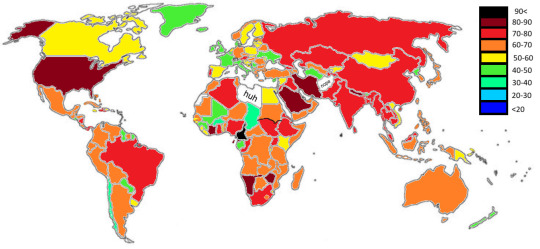
Made a map of the ages of world leaders. Some of it might be incorrect and if I’ve missed something in some country then it doesn’t really matter because this is just to show the general ages.
5 notes
·
View notes
Text

seth was so fucking real for this I had to learn R for my degree and it fucking suuucked 😡😤
#we used it for statistical coding cuz theres a ton of handy packages for hyperspecific data processing#like I used it a ton in the course I did on phylogeny for mapping genomes + taxonomies + finding linked sections of alleles etc#and also for generating boring regular visual stuff like histograms for my final year project lol#i love how reference dense this book is there are so many little things I notice that im like hey! ik abt that!#but i imagine theres way way more that goes completely over my head... so impressive to be able to write like this goddamn#.diaries#exordia#hannibal ref a few pages later lmaoooo..#anyway who wanna talk math while being decontaminated naked. and we were both girls 😳#i did actually once forget i was in the middle of having sex bc i was too focused on talking abt math. chaya + li let me innnn
2 notes
·
View notes
Text
i made jokes about wishing i had dad autism instead of like mcr special interest and now i cant shut up about linguistics and the history and variations of american liscence plates :/
#be careful what u wish for#jk im not actually upset#also topographical maps#and maps in general#and statistics#and also public transportation#imagine how incredible an expansive and developed high speed rail system would be in america#people who say ooooh no we couldnt america too big :( midwest too rural i need my big fucking truck :( shut up shut up shut up
3 notes
·
View notes
Text

Water quality of bathing coastal sites in Europe
#Europe#maps#map#statistics#Greece#Croatia#Mediterranean sea#Mediterranean#European facts#Greek facts
54 notes
·
View notes
Text
What Do You Call That Bug: Bug Map Survey Results 2.0

The results are in for wave 2 of my survey about the vernacular names for a particular kind of bug! Before I get into it, I should mention that I’ve left the survey open to allow for possible future waves of data analysis, so if you haven’t completed the survey but would like to, you may do so here (be aware that the survey contains a photo of the bug in question!). Also, if you’d just like to see a photo of the relevant bug, you may do so here.
Including the data from wave 1, I got a total of 1,091 survey responses. I’ll include a detailed breakdown of the sample at the end for reference, but the important things to know are that a majority of respondents (78%) are American, and that I advertised the survey on both Tumblr and Reddit (r/SampleSize) this time, so I’ve included a couple of Reddit vs Tumblr subsample comparisons.
With that out of the way, onto the results!
Names for That Bug
Here’s how often each of the names for That Bug were selected, specifically among respondents who were familiar with the bug (how I defined “familiar” is included at the end, for the curious):

For the sample overall, “Jerusalem cricket” is solidly the most commonly-selected name, being chosen by a majority of respondents (57.2%). “Potato bug” was a distant second at 34.1%, followed by sand cricket at 17.8%. All other terms were fairly uncommon, with a selection rate of ~5% or less.
Respondents were allowed to select multiple names, but most only selected a single term (249/320, or ~78% of the familiar respondents). However, among familiar respondents who selected more than 1 name, nearly half specifically selected the combination of “Jerusalem cricket” and “potato bug” (32 selecting that combination vs. 38 selecting some other combination of names).

A number of respondents wrote that they would just call That Bug a “cricket”, which I considered too general to group with the other names that are more specific to That Bug. A pretty solid handful of folks guessed that it might be a mole cricket, but that’s actually a different critter (although it does look very similar and so it is understandable that it could be confused for That Bug). A few folks also guessed that it was a weta, which also looks quite similar and is in fact fairly closely related to That Bug, being part of the same superfamily (Stenopelmatoidea).
Names by Region
Here’s how the selected names varied by US region:

“Jerusalem cricket” was the top name across the board, but how dominant it was over “potato bug” and “sand cricket” varied a bit. “Child of the Earth” also appears to be more common in the West than elsewhere, which is worth examining further.
What happens when you look at the more specific sub-regions? Let’s find out!
“Jerusalem cricket” is reasonably common everywhere (although it ranges from being selected just under half the time to roughly 2/3rds of the time):
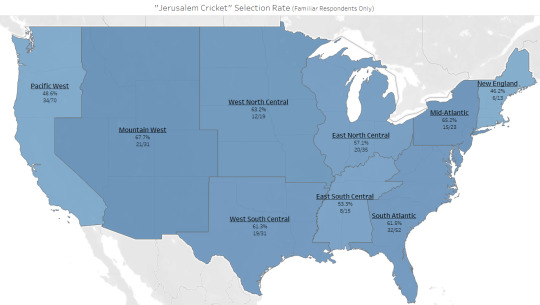
“Potato bug” varies much more dramatically by sub-region, being selected by a majority of respondents in the Pacific West but occurring much less often elsewhere, including the neighboring Mountain West, where it was only selected ~13% of the time!:
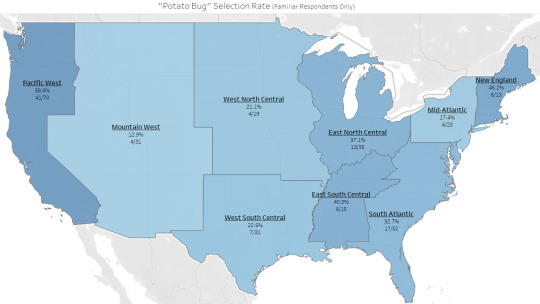
“Sand cricket” was somewhat uncommon across most sub-regions with a roughly 20-30% selection rate, on average, although it was notably less common in the Pacific West than anywhere else (only ~6%!):

Finally, “Child of the Earth” occurred rarely or never in most sub-regions, but emerged as a somewhat uncommon but not outright rare term in the Mountain West:

Notably, every single familiar respondent from New Mexico (n = 4 only, but still) selected “Child of the Earth”. It was also selected by a handful of respondents in Arizona and California, lending credence to it possibly being a Southwestern regional term.
Overall, one of the striking differences across sub-regions is the extent to which “Jerusalem cricket” is selected relative to “potato bug”, as shown here:
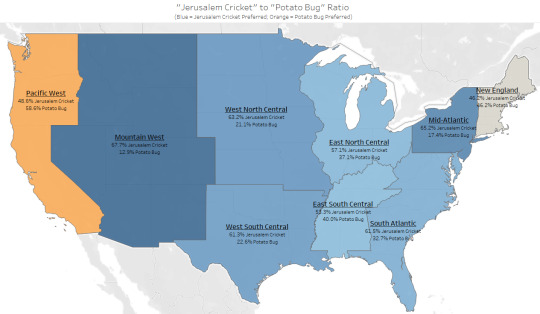
Notably, the Pacific West, unlike all other regions, showed a preference for “potato bug” over “Jerusalem cricket”. This was fascinating to me, so I looked into it a little more, and it appears that this is driven predominantly by Californians preferring “potato bug” (66%:45%), since Oregonians and Washingtonians preferred “Jerusalem cricket”:

It’s worth noting that a few other states besides California (Illinois, Michigan, South Carolina, and New Hampshire) show numerical preference for “potato bug” over “Jerusalem cricket,” but each of them has very small sample sizes (<10 familiar respondents), so I wouldn’t take the pattern too seriously for those other states.
Sample sizes for state-level maps are generally QUITE small (the sub-region maps are already probably pushing it a bit, tbh), but what if we throw caution to the wind and look at the most commonly selected name for each state anyway? HUGE asterisk to this map in that a pretty substantial majority of states are based on very small sample sizes and so this should be taken with a MAJOR grain of salt, but here’s what you get (it’s probably the closest I’ve come to my original Bug Map vision so far ~):
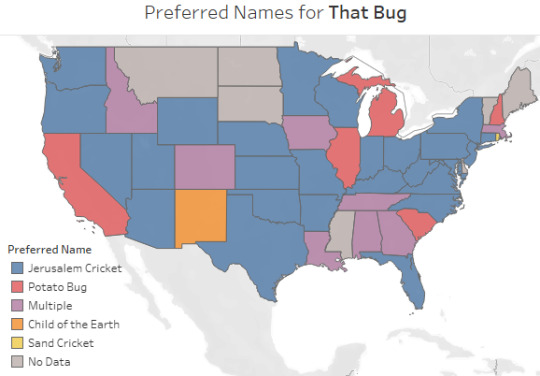
Shout-out to the sole Rhode Island respondent who was able to unilaterally dictate that Rhode Island, in contrast to all other states, would have “sand cricket” as the state’s preferred term for That Bug on my silly map. That’s the kind of power I aspire to every day :)
Anyway, to sum up, “Jerusalem cricket” is generally the preferred name for That Bug, but “potato bug” is its most common name in California (and potentially a few other states), and “Child of the Earth” is its preferred name in New Mexico (and may generally be a regional term in the Southwestern US).
Familiarity with That Bug
Overall, 29.3% of respondents were familiar with That Bug. And, unsurprisingly, given that it’s a North American insect, Americans were significantly more familiar with it than non-Americans, with 34.3% of American respondents recognizing the bug, compared to 11.3% of non-Americans.
Here’s how the familiarity rate varies by sub-region:

Overall, respondents from the Western US were more familiar with That Bug than were respondents from Eastern states, with the Pacific West having the highest percentage of respondents who recognized the bug (45.8%) and the Mid-Atlantic having the lowest among Americans (22.8%), although the familiarity rate among Mid-Atlantic respondents was still twice that of non-Americans (11.3%).
Tumblr vs Reddit Comparisons
A significantly higher percentage of the Tumblr sample was familiar with That Bug (34.8%) compared to the Reddit subsample (17.3%), with this pattern extending to both American and non-American respondents:

I suspect this difference is likely due to the tagging and reblogging features of Tumblr meaning that the survey was likely seen by a greater proportion of “bug enthusiasts” on Tumblr compared to Reddit.
In support of that explanation, the Tumblr comments about the bug were more likely to be positive rather than negative in tone (47:34), while the reverse was true for the Reddit sample (16:6; a statistically significant difference, fwiw, at χ2 = 6.55, p = .01):

From this, I would suspect that the Reddit familiarity rate is probably more accurate to the general population, although I would suspect that it is probably still inflated from the “true” percentage, since respondents had to opt-in to filling out a survey about a bug to be counted at all.
The Reddit/Tumblr subsamples were otherwise generally pretty similar to each other.
Conclusions
In sum, That Bug is relatively obscure, with only around a third of Americans and a tenth of non-Americans recognizing it. Among those who did recognize it, That Bug was most widely known as a “Jerusalem cricket”, but its other names saw some use, too. “Potato bug” was the most common term for it among Californians, for example, while New Mexicans preferred “Child of the Earth.” And, of course, our esteemed Rhode Island representative went with “sand cricket” ~
Personally, I’m from the Western US, and before doing this project, I’d never heard of the term “potato bug” used for anything other than roly-polies (and, based on the comments, I’m not the only one with this experience). It’s fascinating to me how these common names can refer to wildly different things, without people even necessarily being aware of the potential alternate meanings!
I do wonder, however, whether a subset of respondents might have selected “potato bug” because they’d heard the term before, but potentially had (without their knowledge) only heard it being used to refer to a different kind of bug entirely. I don’t have a great way to test that currently, but I am considering doing a follow-up survey about that some day.
Anyway, that’s all for now! Thanks again to everyone who completed the survey or who read any of this! <3
---
Other Stuff
Wave 1 results post
Familiarity definition: Respondents were considered “familiar” with That Bug for the purposes of this analysis if they did NOT select the “I am unfamiliar with this bug” option AND provided a valid name for the bug, either by selecting one of the provided options OR providing a specific name in the “other” text. Overly vague responses (e.g., “cricket”) or names of other bugs (e.g., mole cricket) were not considered valid names for this purpose.
Sample details: Here’s a couple of tables with the sample broken down by source and region. The non-parenthetical numbers are the total responses and the parenthetical numbers are the number of “familiar” respondents.
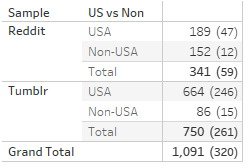
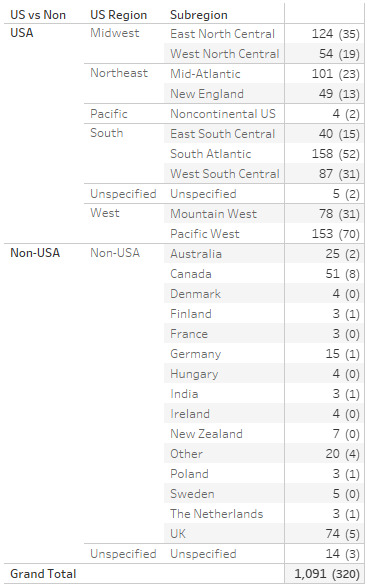
#Bug Map#Bug#Bugs#Insects#Surveys#Survey#Survey results#Data#Research#Graphs#Maps#Entomology#Statistics#Linguistics#Dialects#sC original#Jerusalem cricket#Potato bug#Sand cricket#Child of the Earth#Sand puppy#Skull cricket#Stone cricket#Devil's baby#Satan fetus#Jailbug#<-in my heart#That Bug#Bug Map 2#I told myself I wouldn't write a whole dang thesis of a post this time but we can both see how well that turned out
2 notes
·
View notes
Text
How do you take a plot as amazing-on-paper as “highly intelligent alien race discovers autism and decides to come to Earth because they see it as an incredible asset and want to add it to their gene pool” and flatten it into the most boring “grizzled soldiers swear and shoot at stuff for 107 minutes” while also managing to staunchly avoid ANY sort of meaningful or interesting philosophy about neurodivergence and the subjectivity of what we consider to be disabilities. Anyway I watched The Predator (2018) last night
#I shouldve known I KNOW the Predator movies are always hyper-macho military bro schlock that NEVER appeals to me#but I keep trying them bc I think the Yautja are just so cool in concept 😭#and I knew this one had to do with autism as a motive for the Predators and I was like oh that’s a cool concept tho…#also btw the way the autistic kid was portrayed was so annoying and also the fact that the adults straight up called him r*tarded?!?#in 2018 that was deemed ok??#and of course he was a savant who could memorize maps and rooms full of chess boards at a glance#very realistic very statistically likely that the son of an idiot American soldier who happened to see the ship land would be that way
4 notes
·
View notes
Text
Good news, all my shit went through so I'm now officially going to begin my masters this fall :)
#yall i get to make maps and do statistics and make data sheets#and i am very excited#i love making maps#:)))))#and by shit i mean my student loans finally came in#will i be in debt?#yeah#who cares i get access to a stupid ass expensive map making program now#and i get to learn more about spatial analysis and geospatial statistics#:))))))))
14 notes
·
View notes

